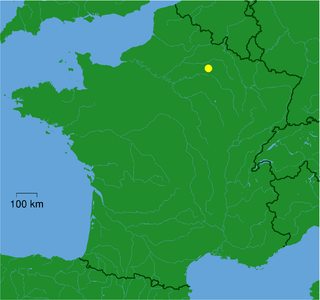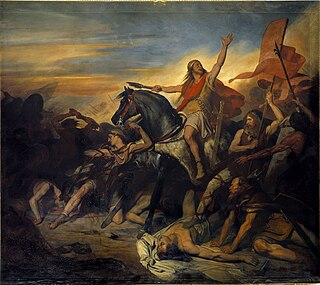 W
WThe Battle of Brumath in 356 AD was part of Roman Emperor Julian's campaigns against the Germanic tribes. Following the Battle of Reims, Julian's forces pursued several Germanic war bands through the Gallic countryside. Outside Brocomagus (Brumath), one war band met Julian in open battle and the Romans were victorious.Hearing therefore that Strasburg, Brumath, Saverne, Seltz, Speyer, Worms, and Mayence were held by the savages, who were living on their lands, he first of all seized Brumath, but while he was still approaching it a band of Germans met him and offered battle. Julian drew up his forces in the form of a crescent, and when the fight began to come to close quarters, the enemy were overwhelmed by a double danger; some were captured, others were slain in the very heat of the battle, and rest got away, saved by recourse to speed.
 W
WThe Battle of Reims or Battle of Durocortorum was fought in 356 between the Western Roman army led by Western Roman Emperor Julian and the Alemanni. The Alemanni were victorious.And after staying there [ Troyes ] a short time, out of consideration for this tired soldiers, he felt that he ought not to delay, and made for the city of Rheims (Durocortōrum). There he had ordered the whole army to assemble with provisions for a month and to await his coming; the place was commanded by Ursicinus' successor Marcellus, and Ursicinus himself was directed to serve in the same region until the end of the campaign. Accordingly, after the expression of many various opinions, it was agreed to attack the Alamannic horde by way of the Ten Cantons [ Dieuze] with closed ranks; and the soldiers went on in that direction with unusual alacrity. And because the day was misty and overcast, so then even objects close at hand could not be seen, the enemy, aided by their acquaintance with the country, went around by way of a crossroad and made an attack on the two legions bringing up the rear of the Caesar's army. And they would nearly have annihilated them, had not the shouts that they suddenly raised brought up the reinforcements of our allies. Then and thereafter, thinking that he could cross neither roads nor rivers without ambuscades, Julian was wary and hesitant,
 W
WThe Battle of Lake Benacus was fought along the banks of Lake Garda in northern Italy, which was known to the Romans as Benacus, in 268 or early 269 CE, between the army under the command of the Roman Emperor Claudius II and the Germanic tribes of the Alamanni and Juthungi.
 W
WThe Battle of Lingones was fought in 298 between the Western Roman Empire and the Alamanni. The Roman force was led by Constantius Chlorus, and was victorious.
 W
WThe Battle of Mediolanum took place in 259, between the Alemanni and the Roman legions under the command of Emperor Gallienus.
 W
WThe Battle of Ticinum, or Battle of Pavia, was fought in 271 near Ticinum (Pavia) in Italy, and resulted in the Roman Emperor Aurelian destroying the retreating Juthungi army.
 W
WThe Battle of Solicinium was fought in 368 between a Roman army and the Alemanni. The Roman force was led by Emperor Valentinian I, and they managed to repel the Alemanni but suffered heavy losses during the battle.
 W
WThe Battle of Tolbiac was fought between the Franks, who were fighting under Clovis I, and the Alamanni, whose leader is not known. The date of the battle has traditionally been given as 496, though other accounts suggest it may either have been fought earlier, in the 480s or early 490s, or later, in 506. The site of "Tolbiac", or "Tolbiacum", is usually given as Zülpich, North Rhine-Westphalia, about 60 km east of what is now the German-Belgian frontier. The Franks were successful at Tolbiac and established their dominance over the Alamanni.
 W
WThe Battle of Strasbourg, also known as the Battle of Argentoratum, was fought in 357 between the Western Roman army under the Caesar Julian and the Alamanni tribal confederation led by the joint paramount King Chnodomar. The battle took place near Strasbourg, called Argentoratum in Ammianus Marcellinus' account, Argentorate in the Tabula Peutingeriana.
 W
WThe Battle of Tolbiac was fought between the Franks, who were fighting under Clovis I, and the Alamanni, whose leader is not known. The date of the battle has traditionally been given as 496, though other accounts suggest it may either have been fought earlier, in the 480s or early 490s, or later, in 506. The site of "Tolbiac", or "Tolbiacum", is usually given as Zülpich, North Rhine-Westphalia, about 60 km east of what is now the German-Belgian frontier. The Franks were successful at Tolbiac and established their dominance over the Alamanni.